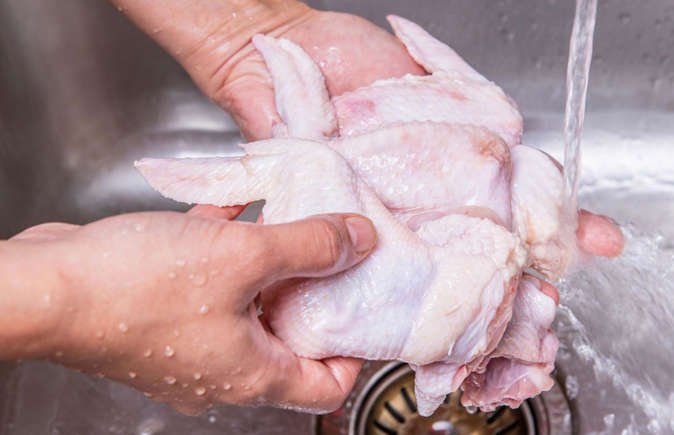Table of Contents
Food poisoning is a common and preventable illness, but many people unknowingly make mistakes in their kitchens that put them at risk. From improper food handling to unsafe cooking practices, these errors can lead to harmful bacteria and pathogens entering your food, causing serious health problems. While some of these mistakes may seem trivial, the impact they can have on your health is anything but.
In this comprehensive guide, we will explore 21 common cooking errors that could lead to food poisoning, and how you can avoid them. These tips are based on expert advice from the British Food Standards Agency (FSA), NHS, and the United States Department of Agriculture (USDA), ensuring that you receive accurate, evidence-based recommendations to keep your kitchen safe. By making a few simple adjustments in your cooking habits, you can drastically reduce the risk of foodborne illnesses and keep your meals both delicious and safe to eat.
1. Buying Frozen Goods Early in Your Shop
You may be tempted to pick up frozen food first when you do your grocery shopping, but this could be a costly mistake. Frozen foods should always be the last items you purchase to ensure they stay frozen and don’t warm up while you shop. If frozen products thaw and then refreeze, they become susceptible to bacterial growth, increasing the risk of food poisoning. Always ensure frozen goods are the last items to be placed in your cart, and head straight to the checkout afterward to minimize any thawing time.
2. Choosing Broken Packages
When purchasing food, it’s vital to check the packaging for any signs of damage, such as tears, punctures, or broken seals. Damaged packaging can compromise the quality of the food inside, increasing the risk of contamination. Food with broken seals may have been exposed to unsanitary conditions, allowing harmful bacteria to enter and multiply. If you notice any broken packaging, it’s best to avoid purchasing the item.
3. Mixing Raw Meat with Other Produce
Cross-contamination is one of the leading causes of foodborne illnesses, and it can happen long before you even start cooking. When shopping, never place raw meat, poultry, or seafood with other produce. Always keep raw meats in separate bags and away from fruits and vegetables to prevent harmful bacteria from transferring. Cross-contamination can occur not just in the cart, but also on your countertop and cutting boards, which brings us to the next mistake.
4. Using the Wrong Chopping Boards
Using the same chopping board for raw meat and vegetables is a recipe for disaster. Raw meat often carries harmful bacteria like salmonella or E. coli, and if it comes into contact with other foods, it can contaminate them, leading to food poisoning. The best practice is to use separate chopping boards for raw meat, poultry, and seafood, and another for vegetables, fruits, and ready-to-eat foods. If you only have one board, ensure you thoroughly wash and sanitize it between uses.
5. Reheating Rice Improperly
Rice is a common culprit in food poisoning cases, specifically due to the bacterium Bacillus cereus. If rice is not stored or reheated properly, it can cause vomiting and diarrhea. When cooking rice, ensure that it is cooled down within one hour of cooking and stored in the refrigerator. Leftover rice should not be kept for more than one day, and when reheating, make sure it reaches a piping hot temperature all the way through. Never reheat rice more than once, as this increases the chances of bacterial growth.
6. Not Washing Berries
Berries like strawberries, raspberries, and blackberries are delicious but also highly susceptible to contamination from harmful bacteria. Due to their delicate nature, they can easily pick up viruses and bacteria from contaminated water, or during handling and processing. Always rinse berries under cold water before eating them, but don’t wash them until just before you’re ready to consume them, as moisture can reduce their shelf life.
7. Not Washing Melon Rinds
Melons like cantaloupe, watermelon, and honeydew melon are often grown on the ground and have rough, porous rinds that can harbor bacteria like listeria. When cutting melons, always wash the rind thoroughly to remove any bacteria, and use a clean knife to cut through the melon. Additionally, ensure that you don’t allow the rind to come into contact with the flesh when cutting the fruit.
8. Cooking with Open Wounds
A seemingly minor cut on your hand could introduce bacteria into the food you’re preparing. Even tiny cuts can harbor harmful microorganisms, which could contaminate the food and lead to food poisoning. Always make sure to cover any open wounds with a bandage before cooking. It’s also a good idea to wear disposable gloves to reduce the risk of contamination, especially when handling raw meats or other potentially hazardous foods.
9. Relying on Smell to Determine Food Freshness
Smelling food to check whether it’s gone off is an unreliable method. While some spoiled foods may emit an unpleasant odor, not all bacteria produce a noticeable smell. A piece of meat, for example, can be contaminated with harmful pathogens even if it doesn’t smell bad. Always check the food’s use-by date and inspect its appearance. If in doubt, discard the food rather than taking the risk of food poisoning.
10. Placing Warm Food Directly in the Fridge
Placing hot food directly into the fridge can raise the internal temperature of the refrigerator, potentially causing the surrounding food to enter the “danger zone” for bacterial growth. To avoid this, allow food to cool down to room temperature before placing it in the refrigerator. To speed up the cooling process, divide large portions of food into smaller containers, spread food like rice on a tray, or use ice water baths for fast cooling.
11. Re-Freezing Melted Ice Cream
Once ice cream has thawed, it is no longer safe to refreeze. Thawing and refreezing ice cream can promote the growth of harmful bacteria like listeria. Always store ice cream in the freezer immediately after purchasing it, and avoid leaving it out for extended periods. If ice cream does melt, discard any remaining portion that wasn’t consumed immediately.
12. Leaving Leftovers Too Long
Leftovers that are left at room temperature for too long can become breeding grounds for harmful bacteria. The general rule is that leftovers should be refrigerated within two hours of being cooked. If the temperature is particularly hot (above 90°F), leftovers should be refrigerated within one hour. Always eat leftovers within two days to minimize the risk of foodborne illness.
13. Keeping Raw Meat Too Long
Fresh meat, poultry, and seafood should be used or frozen within a few days of purchase. Storing raw meat for too long increases the chances of bacteria growth, which can cause food poisoning. Always check the expiration dates on packaging, and when in doubt, freeze items that you don’t plan to use within the recommended time frame.
14. Eating Buffet Food Left Out Too Long
Buffet-style food is often left out for hours, making it a prime candidate for foodborne illness. Risky foods like eggs, rice, meats, and seafood need to be kept at the proper temperature to prevent bacterial growth. Ideally, these foods should not be left out for more than two hours (or one hour if it’s a hot day). If you’re uncertain about how long food has been sitting out, it’s better to skip it altogether.
15. Storing Raw Meat on the Top Shelf of the Fridge
Raw meat should always be stored on the bottom shelf of the fridge, in a sealed container to prevent its juices from dripping onto other foods. Keeping raw meat on the top shelf of the fridge increases the risk of cross-contamination, as juices from the meat can easily spill onto ready-to-eat foods, increasing the risk of food poisoning.
16. Eating Undercooked Meat
Undercooked meat can harbor harmful bacteria like salmonella, E. coli, and listeria, which can cause severe food poisoning. Always use a food thermometer to check the internal temperature of meats to ensure they are cooked to a safe level. Beef, lamb, and pork should reach at least 145°F, while chicken should be cooked to 165°F to kill any harmful pathogens.
17. Washing Raw Meat
Washing raw meat, such as chicken or turkey, is a dangerous myth that could actually spread bacteria throughout your kitchen. Water splashes can carry bacteria from the meat to countertops, utensils, and other foods. The safest way to handle raw meat is to simply cook it thoroughly, which will kill any harmful bacteria present.
18. Using the Same Tongs for Raw and Cooked Meat on the Grill
Using the same tongs for raw and cooked meat increases the risk of cross-contamination, particularly when grilling. Bacteria from raw meats can easily transfer to the cooked items, making them unsafe to eat. To avoid this, use separate tongs for raw and cooked food, or designate different colored tongs to clearly distinguish between the two.
19. Overfilling the Refrigerator
When you cram too much food into the fridge, you prevent the cold air from circulating properly, which can cause the temperature inside to rise. Bacteria grow most rapidly in temperatures between 46°F and 140°F, so it’s essential to leave space for proper air circulation. Overcrowding can also lead to uneven cooling of food, increasing the risk of contamination.
20. Defrosting Food on the Counter
Defrosting frozen food at room temperature is risky, as bacteria can rapidly multiply when food is in the “danger zone” (between 40°F and 140°F). The safest way to defrost food is in the refrigerator, where the temperature remains consistently below 40°F. If you need to defrost food more quickly, use the microwave or cold water methods.
21. Storing Opened Canned Food in the Refrigerator
Once you open a can, you should never store the remaining food in the can itself. The metal can react with the food and give it a metallic taste. Instead, transfer the contents into a clean, airtight container before refrigerating it. Always check the expiration date on canned goods and consume them within the recommended time frame.
Call to Action: Stay ahead with the latest news on global food safety, health, and innovations. Join us on WhatsApp or Telegram for real-time updates. Have a report or article? Send it to report@theinnovationtimes.com. For more news, follow us on X (Twitter), Instagram, LinkedIn, YouTube, Pinterest, and Facebook for continuous insights.



